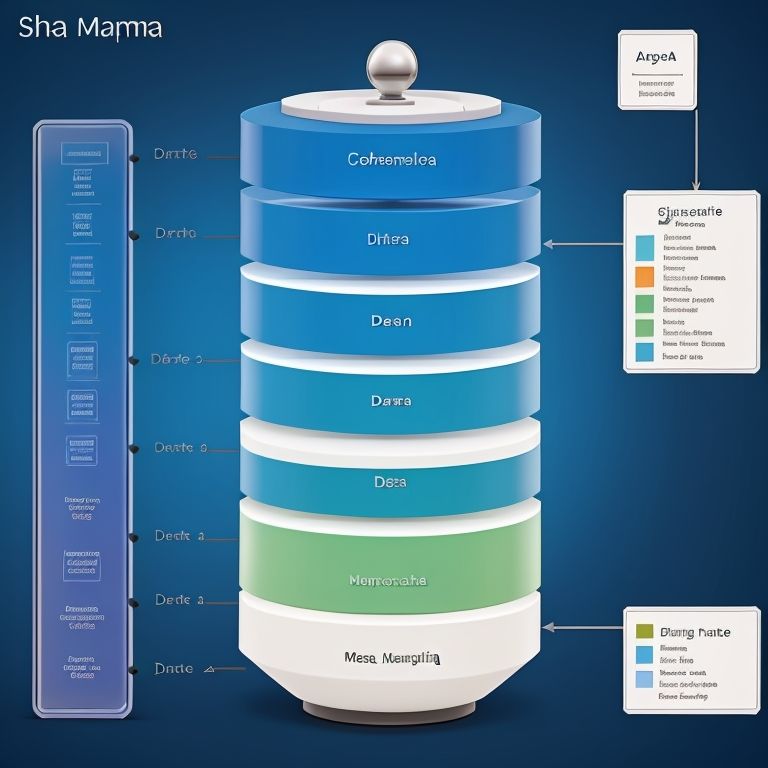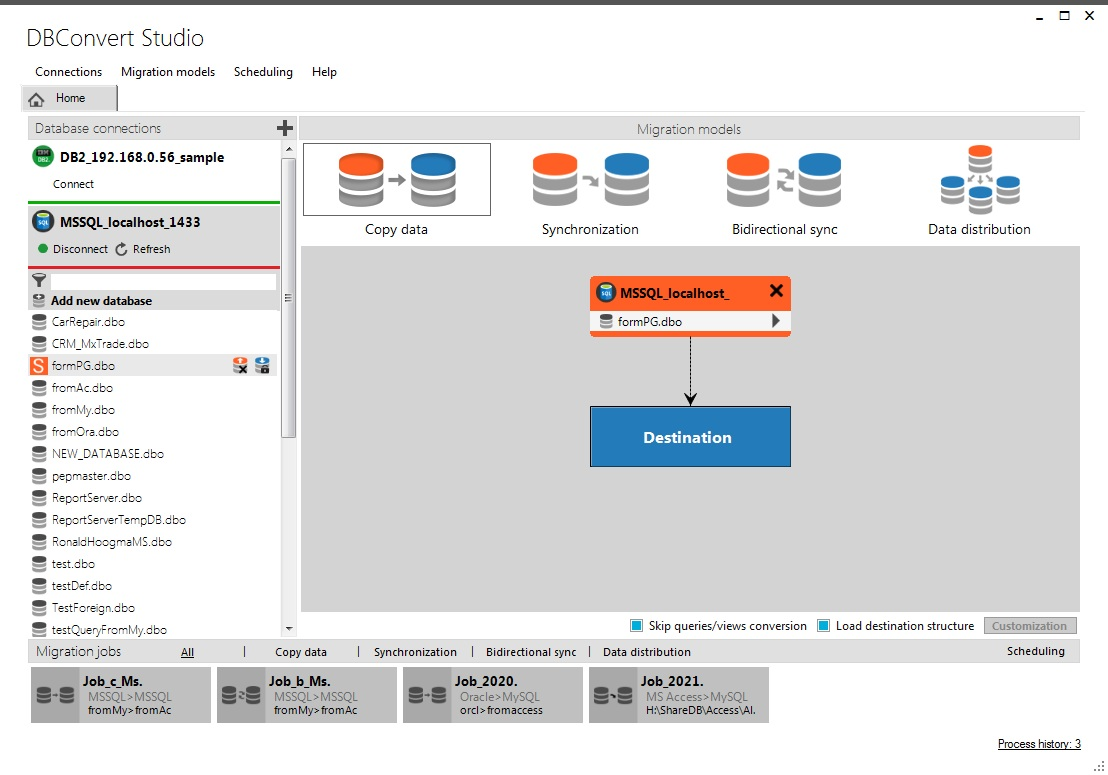Your Roadmap to Database Conversion Excellence.
This guide explores the importance of database migration for adapting to evolving application needs and highlights key considerations and benefits, including improved performance and cost savings through open-source solutions.

Introduction:
Section 1: Planning Your Database Migration
Section 2: Preparing for the Migration
Section 3: Performing the Database Conversion
Section 4: Handling Data and Application Code
Section 5: Post-Migration Testing and Verification
Section 6: Monitoring and Maintenance
Section 7: Best Practices and Tips
Conclusion
Introduction:
Database management systems (DBMS) are the backbone of modern applications and are pivotal in storing and managing critical data. As applications evolve and expand, the necessity for migrating from one DBMS to another frequently arises. This comprehensive guide will delve into the intricate database conversion process, addressing common challenges encountered when transitioning between various DBMS platforms. Whether you're moving from MySQL to PostgreSQL, Oracle to SQL Server, or any other combination, this guide aims to provide valuable insights into seamless database migration.
The Significance of Database Migration:
Database migration is a significant undertaking that various factors can drive. It's a strategic move to ensure your data infrastructure aligns with your application's evolving requirements. Common motivations for database migration include:
- Performance Optimization: Over time, an application's performance requirements can change. Migrating to a different DBMS can provide better scalability and performance capabilities.
- Feature Set: For example, MySQL and PostgreSQL exhibit unique sets of features. The article "MySQL vs. PostgreSQL" comprehensively analyzes the tangible differences that set MySQL and PostgreSQL apart.
- Cost Efficiency: Cost considerations often play a role. PostgreSQL is known for its robust open-source community, making it an attractive option for those seeking cost-effective solutions.
- Vendor Lock-In: Some organizations migrate to open-source alternatives like PostgreSQL from proprietary systems to avoid vendor lock-in.
Popular Databases:

MySQL, PostgreSQL, Oracle and MS SQL Server have earned their popularity in relational databases, each with unique strengths.
| Database | Strengths |
|---|---|
| MySQL |
Excellent for web applications, content management systems, and data-driven websites. Widely adopted by companies of all sizes. |
| PostgreSQL |
Well-suited for complex data modeling, full-text search, geospatial data, and extensive customization. |
| Oracle |
The top choice for large enterprises and organizations requiring a reliable and robust database management system. |
| Microsoft SQL Server |
|
| Microsoft Access |
Commonly used for small businesses and individuals for lightweight database applications. |
| SQLite |
Ideal for mobile apps, embedded systems, and situations where a small, self-contained database is needed. |
| Firebird |
Suitable for applications requiring high-performance data management and support for complex business logic. |
The Need for Migration:
While both MySQL and PostgreSQL have their strengths, there are scenarios where migrating between them becomes essential. For example:
- Application Growth: As your application grows and demands more complex features, you might find PostgreSQL's advanced capabilities more suitable.
- Data Compatibility: If your data schema evolves or requires better compatibility with specific data types, migrating to PostgreSQL can be advantageous.
- Vendor or Licensing Changes: MySQL licensing or support changes might prompt migrating to an open-source alternative like PostgreSQL.
- Performance Scaling: If your application experiences increased traffic and demands better performance scaling, PostgreSQL might offer a more robust solution.
Reasons for PostgreSQL to MySQL Migration:
- Application Compatibility: Transitioning to a MySQL-centric application ecosystem ensures seamless compatibility and minimizes potential issues.
- Feature Alignment: MySQL offers specific features and extensions that better suit your application's needs, especially if reliant on MySQL-specific functions or plugins.
- Ecosystem Standardization: Aligning with an existing MySQL-based database ecosystem simplifies management and maintenance.
- Performance Optimization: MySQL's performance characteristics may better match your application's workload and query patterns, delivering improved query response times and resource usage.
- Legacy Integration: Facilitate integration with legacy systems or third-party applications requiring MySQL compatibility.
Integration with Microsoft SQL Server (MSSQL) and Oracle:
- Microsoft SQL Server (MSSQL): MSSQL is an ideal choice for organizations deeply integrated into Microsoft's ecosystem. Its compatibility with Microsoft technologies, including Windows Server and Azure, ensures a cohesive environment for managing and analyzing data. Migrating to MSSQL can strengthen the alignment with Microsoft's suite of tools and services.
- Oracle: Migrating to Oracle may be warranted when your organization seeks the utmost data reliability and advanced database capabilities.
These considerations underscore the importance of evaluating your specific database requirements and ecosystem when making migration decisions. Whether moving from PostgreSQL to MySQL, integrating with MSSQL, or adopting Oracle, each choice should align with your application's needs and strategic objectives.
As we embark on this guide, we will delve into the intricacies of planning, executing, and optimizing a successful database migration between different database management systems (DBMS). Whether you're a developer, a database administrator, or an IT decision-maker, this guide will equip you with the knowledge and best practices to navigate the complex terrain of database conversion among these powerful DBMSs.
Section 1: Planning Your Database Migration

Database migration is a complex endeavor that demands careful planning and execution. This section will explore the critical aspects of planning your database migration jobs.
Importance of Planning and Assessing Your Current Database:
- Understanding Your Current State: Before embarking on a migration, thoroughly understanding your existing database is crucial. It encompasses analyzing the schema, data types, indexes, and relationships.
- Data Volume and Complexity: Evaluate the volume and complexity of your data. Large datasets or intricate relationships may impact the migration process and require special attention.
- Data Integrity and Quality: Assess the integrity and quality of your data. Identify any inconsistencies, anomalies, or data quality issues that must be addressed during migration.
- Dependencies and Applications: Identify all dependencies on your database, including applications, scripts, and reporting tools. Understand how the migration will impact these dependencies.
- Performance Metrics: Collect performance metrics for your current database. This data will serve as a baseline for evaluating the performance of the migrated database.
Creating a Migration Strategy and Setting Clear Goals:
- Define Clear Objectives: Clearly articulate the objectives of your migration. Are you seeking improved performance, cost savings, or better compatibility with specific features?
- Choose the Right Migration Path: Decide whether you will perform a homogeneous migration (e.g., MySQL to MySQL) or a heterogeneous migration (e.g., Oracle to PostgreSQL). Your choice will impact the tools and processes you use.
- Select Migration Tools: Research and select the appropriate migration tools and scripts that align with your migration strategy. These tools can help automate various aspects of the migration process.
- Data Mapping and Transformation: Define a data mapping and transformation plan to handle differences in data types, constraints, and schema structures between various database types.
- Testing and Validation: Develop a comprehensive testing plan that includes unit testing, integration testing, and data validation. Ensure that the migrated database meets your performance and functionality goals.
- Rollback Plan: Prepare a rollback plan if unexpected issues arise during migration. This plan should outline steps to revert to the previous state without data loss.
Potential Challenges and How to Overcome Them:
| Challenge | Solution |
|---|---|
| Data Type and Schema Differences |
MySQL, PostgreSQL, MSSQL have different data types and schema structures. Mapping and transforming data can be complex. Solution:
|
| Application Compatibility |
Applications may have queries or code specific to the DBMS. Compatibility issues can arise. Solution:
|
| Data Volume and Downtime |
Large datasets and long migration times can result in significant downtime. Solution:
|
| Data Validation |
Ensuring data integrity and accuracy during migration is essential. Solution:
|
| Performance Optimization |
The performance of the migrated database may need to meet expectations. Solution:
|
By meticulously planning your database migration, defining clear goals, and understanding the potential challenges, you set the foundation for a successful transition. The following sections will dive into the practical steps in executing the migration, including data mapping, code adaptation, and post-migration testing.
Section 2: Preparing for the Migration

A well-prepared foundation is essential for a smooth database migration. This section will explore the prerequisites, backup procedures, and the significance of testing in a controlled environment.
Prerequisites for the Migration Process:
- Database Servers: Ensure your source and target database servers are correctly set up, configured, and accessible.
- Migration Tools: Acquire and install the tools and scripts that align with your migration strategy. Popular tools include DBConvert Studio, pgloader, SQL Server Migration Assistant (SSMA) for MSSQL, Oracle SQL Developer for Oracle databases, and MySQL Workbench for schema conversion.
DBConvert Studio offers the flexibility to convert and synchronize data seamlessly in any combination between different database systems.
- Access Credentials: Have the appropriate access credentials for the source and target databases, including usernames and passwords with sufficient privileges.
- Network Connectivity: Confirm that network connectivity between the source and target databases is stable and secure. Ensure that firewalls and security groups allow the necessary traffic.
- Target Schema: Prepare the target schema structure in your target database. Create tables, indexes, constraints, and sequences to match your source database schema. Tools like DBConvert Studio can generate an equivalent schema on the destination database mirroring the source schema.
How to Back Up Your Existing Database:
- Full Database Backup:
Perform a complete source database backup using tools or database management interfaces. This backup ensures that your data is safe in case of unexpected issues during migration.
To backup a MySQL database, you can use the mysqldump command:
mysqldump -u username -p dbname > backup.sqlFor Oracle databases, you can use the expdp (Data Pump Export) utility:
expdp username/password@tns_alias dumpfile=backup.dmpTo backup a PostgreSQL database, you can use the pg_dump command:
pg_dump -U username dbname > backup.sql
For SQL Server databases, you can use the sqlcmd utility to generate a backup script:
sqlcmd -S servername -d dbname -U username -P password -Q "BACKUP DATABASE dbname TO DISK='backup.bak'"
2. Backup Verification:
After creating the backup, verify its integrity by restoring it to a test environment. Ensure that the restored database is consistent and error-free.
3. Data Consistency During Migration:
Plan to perform a final backup before the migration process begins to capture any changes made to the database during the migration planning phase.
The Importance of Testing in a Controlled Environment:
- Create a Sandbox Environment: Set up a controlled testing environment that mirrors your production environment as closely as possible. This environment should include the target database and any dependent applications.
- Migration Dry Run: Conduct a migration dry run in the sandbox environment. Use a subset of your data to simulate the migration process without affecting the production database. This step allows you to identify and address potential issues before the migration.
- Performance Testing: Assess the performance of the migrated database in the controlled environment. It includes running performance benchmarks and ensuring the database meets your performance expectations.
- Functional Testing: Test all application functionality against the migrated database. Ensure that queries, stored procedures, and application logic work as expected.
- Data Validation: Implement data validation scripts to confirm the accuracy and integrity of the data after migration. Verify that data transformations and mappings are correct.
- User Acceptance Testing (UAT): If applicable, involve end-users in user acceptance testing. Gather feedback and ensure that the migrated system meets user requirements and expectations.
- Rollback Testing: Develop and test your rollback plan in a controlled environment to ensure you can revert to the previous state if necessary.
Testing in a controlled environment is paramount to minimize risks and ensure a successful migration. Any issues identified during testing can be addressed before migrating your production database. The following section will explore the migration process, including data mapping, transformation, and code adaptation.
Section 3: Performing the Database Conversion

Performing a database conversion involves several steps that require careful consideration and execution. This section will guide you through a step-by-step process, provide code examples and scripts, and address data mapping, data type handling, and schema differences.
Step-by-Step Process of Database Migration:
- Schema Assessment: Review the schema of your source database and target database. Identify differences in data types, constraints, and schema structures.
- Data Mapping and Transformation: Create a comprehensive plan for data mapping and transformation. Determine how data from the source db will be mapped to target, considering differences in data types and constraints.
- Schema Conversion: Use migration tools or scripts to convert the schema from the source to destination database syntax. Here's a basic example for converting a table:
-- PostgreSQL
CREATE TABLE "products" (
"id" SERIAL PRIMARY KEY,
"name" VARCHAR(255),
"price" NUMERIC(10, 2)
);/* MySQL */
CREATE TABLE `products` (
`id` INT AUTO_INCREMENT PRIMARY KEY,
`name` VARCHAR(255),
`price` DECIMAL(10, 2)
);/* Oracle */
CREATE TABLE products (
id NUMBER GENERATED BY DEFAULT AS IDENTITY PRIMARY KEY,
name VARCHAR2(255),
price NUMBER(10, 2)
);-- MS SQL Server
CREATE TABLE products (
id INT IDENTITY(1,1) PRIMARY KEY,
name VARCHAR(255),
price NUMERIC(10, 2)
);Schema Conversion with DBConvert Studio: If you prefer an automated approach and want to simplify the schema conversion process, consider using DBConvert Studio. This tool can automatically convert your database schema from the source to the destination database syntax, eliminating the need for manual scripting.
4. Data Migration: Use specialized tools or scripts to migrate. Ensure that data transformations and mappings are correctly applied.
5. Indexes and Constraints: Recreate indexes and constraints in the target database that existed in source.
DBConvert Studio provides an intuitive user interface that allows you to map data types, set constraints, and perform schema transformations with ease. This is especially beneficial for users who may not have extensive scripting experience, streamlining the migration process and reducing the risk of errors.
6. Stored Procedures and Functions: If your application relies on stored procedures or functions, rewrite them in the target's syntax. The logic may need to be adjusted to match the target db procedural language.
7. Views and Triggers: Recreate views and triggers in target db, ensuring they function as intended.
8. Application Code Updates: Modify your application code to adapt to target-specific SQL syntax and features.
Data Mapping, Data Type Handling, and Schema Differences:

- Data Mapping: When performing a database migration, it's crucial to map your data accurately from the source to the target, considering the differences in data types between the database systems.
- Schema Differences: Be aware of schema differences. PostgreSQL is stricter with data type casting and enforces more rigorous SQL standards compliance than MySQL.
- Case Sensitivity: PostgreSQL and Oracle are case-sensitive by default, while MySQL and SQL Server are usually case-sensitive. Ensure that your queries and table/column references match the case sensitivity rules of PostgreSQL.
- Serial Columns: In PostgreSQL, you often use
SERIALdata types for auto-incrementing columns instead of MySQL'sAUTO_INCREMENT. In MS SQL Server, you commonly use theIDENTITYproperty to create auto-increment columns. In Oracle, you typically use aSEQUENCEand a trigger to achieve auto-increment behavior for a column. - Character Encoding: Pay attention to character encoding differences between databases and ensure your data is converted correctly.
- Primary Keys and Unique Constraints: Review primary keys and unique constraints, as they might need to be modified to adhere to target's requirements.
Migrating databases involves careful attention to detail, as differences between databases can impact data integrity and application functionality. Using migration tools and scripts specific to the task can simplify the process. Additionally, thorough testing and validation are essential to ensure a successful migration. The next section will explore the critical aspects of testing and validating the migrated database.
Section 4: Handling Data and Application Code

Migrating a database involves more than just transferring data; it also entails adapting the data and application code to ensure compatibility with the target database system. In this section, we'll discuss the crucial tasks of transforming data and adjusting application code during migration.
Transforming and Adapting Data During Migration:
- Data Mapping and Transformation: As discussed earlier, define a clear data mapping and transformation plan to handle differences in data types, constraints, and schema structures between databases. Use migration tools or scripts to automate data transformation whenever possible.
- Data Cleansing and Validation: Before migrating data, perform data cleansing and validation to address data quality issues, anomalies, or inconsistencies. Ensure that data integrity is maintained throughout the migration process.
- Null Handling: Be mindful of how NULL values are handled in your data. PostgreSQL, MSSQL and Oracle may have different default behaviors for NULL values compared to MySQL. In MySQL, NULL is a special marker used to indicate that a data value does not exist in the database. It represents the absence of a value or an unknown value. Adjust your data accordingly.
- Date and Time Conversions: When migrating date and time values between DBMSs like Oracle, MSSQL, MySQL, and PostgreSQL, it's essential to understand the date types, formats, and time zone handling specific to each system. You may need to use conversion functions and update time zone data to ensure accurate date and time representations in the target database.
Adjusting Application Code and Queries for Compatibility:
- SQL Syntax Differences: Review your application's SQL queries and adapt them to target db syntax. Pay attention to differences in date functions, string concatenation, and mathematical operations.
- Quoting Identifiers: PostgreSQL and Oracle uses double quotes (
") for quoting identifiers (table and column names with spaces or special characters), while MySQL uses backticks. Adjust your queries accordingly. In MSSQL, identifiers are typically enclosed in square brackets ([]) or (") for quoting. - Stored Procedures and Functions: To ensure a smooth database migration, rewrite stored procedures, functions, and triggers to match the procedural language of the target DBMS. Common languages include:
- MySQL: SQL/PSM
- MSSQL: T-SQL
- PostgreSQL: PL/pgSQL (with support for other languages)
- Oracle: PL/SQL
- Database Connection Parameters: Update your application's database connection parameters to connect to the target database. Adjust the host, port, username, and password as needed.
- Data Retrieval Methods: Modify data retrieval methods in your application code to handle differences in how data is returned by DBMS.
- Testing and Validation: Rigorously test your application after making code adjustments to ensure it functions correctly with the migrated database.
- User Training: Train users and developers on any changes introduced by the migration, including differences in SQL syntax and database behavior.
- Documentation Updates: Update your application's documentation to reflect any changes in database interactions and queries due to the migration.
- Backward Compatibility: Consider maintaining backward compatibility with the original database system during the transition period, especially if the migration is part of a phased approach.
Adapting your application code and queries is critical to a successful database migration. It ensures that your application continues to function as expected and takes full advantage of the capabilities of the target database system. Thorough testing and validation of the application are essential to catch any compatibility issues early in the migration process. The next section will explore the importance of post-migration testing and verification.
Section 5: Post-Migration Testing and Verification

The work doesn't end once the data and application code have been migrated. Dedicating time and resources to thorough post-migration testing and verification is crucial. In this section, we'll emphasize the importance of these steps and discuss how to ensure data integrity and functionality while handling unforeseen issues.
The Importance of Thorough Testing Post-Migration:
- Data Integrity Assurance: Post-migration testing is essential to verify that data has been accurately and completely migrated from the source database to the target database. Confirm that primary keys, foreign keys, and constraints are functioning as expected.
- Application Functionality Validation: Ensure that all aspects of your application, including user interfaces, reports, and backend processes, work as expected with the migrated database. Test all application functions and features to guarantee they continue performing as intended.
- Performance Evaluation: Benchmark the performance of the migrated database against predefined criteria and expectations: measure query response times and system resource utilization. Identify and address any performance bottlenecks or issues.
- Data Validation: Implement comprehensive data validation scripts to confirm the accuracy and integrity of data in the migrated database. Verify that data transformations and mappings have been executed correctly.
- User Acceptance Testing (UAT): Involve end-users and stakeholders in user acceptance testing. Gather feedback on the functionality and usability of the application with the new database.
Verifying Data Integrity and Functionality:
- Data Validation Queries: Develop SQL queries and scripts to validate data integrity. Check for data anomalies, missing records, and inconsistencies.
- Regression Testing: Perform regression testing on your application to ensure the migration hasn't compromised existing functionality. Re-run previously successful test cases to verify that they still pass.
- Boundary Testing: Test boundary conditions and edge cases to ensure that the migrated system can handle extreme scenarios without issues.
- Security and Access Control: Validate that the target database has correctly implemented security measures and access controls. Ensure that only authorized users can access sensitive data.
- Load and Stress Testing: Conduct load and stress testing to assess how the system behaves under heavy loads. Identify performance bottlenecks and scalability issues.
- Backup and Recovery Testing: Test backup and recovery procedures to ensure data can be restored in case of unexpected issues. Verify that the rollback plan is functional.
Handling Unforeseen Issues:
- Issue Identification: Be prepared to identify and document any unforeseen issues during post-migration testing—track issues related to data, functionality, and performance.
- Issue Prioritization: Prioritize issues based on their impact on data integrity, functionality, and business operations. Address critical issues promptly.
- Root Cause Analysis: Conduct a thorough root cause analysis for critical issues to understand the underlying reasons. This analysis can inform corrective actions.
- Issue Resolution: Collaborate with the database migration team, developers, and stakeholders to resolve identified issues. Implement fixes, code changes, or adjustments as needed.
- Communication and Documentation: Maintain clear communication with stakeholders throughout the issue resolution process. Document the steps taken to address issues and their outcomes.
Post-migration testing is a critical phase that ensures a successful transition to the new database system. It helps maintain data integrity, assures application functionality, and prepares your organization for unexpected challenges. Be vigilant, organized, and responsive to issues that may arise, and remember that post-migration testing is an ongoing process that continues even after the migration is complete. The following section will explore best practices and tips for a successful database conversion.
Section 6: Monitoring and Maintenance

The section of our guide focuses on the critical aspects of ongoing monitoring and maintenance for your database system post-migration. We'll discuss the importance of these activities, highlight tools and techniques for performance monitoring, and provide guidance on troubleshooting common issues.
Ongoing Monitoring and Maintenance Post-Migration:
- Continuous Monitoring: Establish a robust monitoring system to keep a close eye on the health and performance of your migrated database. Regularly review system metrics, logs, and alerts.
- Database Backups: Maintain a reliable backup strategy, including regular full and incremental backups. Test the restoration process periodically to ensure data recoverability.
- Routine Maintenance Tasks: Schedule everyday maintenance tasks, such as vacuuming, reindexing, and compaction, to optimize database performance and prevent fragmentation.
- Security Audits: Conduct regular security audits and vulnerability assessments to identify and address potential security risks and vulnerabilities.
- Performance Tuning: Continuously fine-tune your database for optimal performance. Analyze query execution plans, optimize indexes, and adjust configuration settings.
Tools and Techniques for Performance Monitoring:
- Database Management Systems (DBMS) Tools: Most DBMSs offer built-in performance monitoring and optimization tools. Familiarize yourself with the tools provided by your specific DBMS.
- Third-Party Monitoring Tools: Consider using third-party monitoring tools such as Prometheus or Grafana for advanced performance monitoring, alerting, and visualization.
- Query Profiling: Use query profiling tools to analyze and optimize slow or resource-intensive queries. Identify bottlenecks and make necessary adjustments.
- Log Analysis: Regularly review database logs for error messages, warnings, and performance-related information. Log aggregation tools like ELK Stack can be invaluable.
Troubleshooting Common Issues:

- Performance Degradation: If you notice performance degradation, investigate the root cause by analyzing query performance and system metrics. Adjust configurations, optimize queries, and consider hardware upgrades if necessary.
- Concurrency Issues: Monitor database locks and concurrent connections. Address contention issues by optimizing transactions and locking strategies.
- Data Corruption: Implement integrity checks and regularly validate data to promptly detect and rectify data corruption issues.
- Security Breaches: In case of a security breach or data breach, follow your incident response plan. Investigate the breach, implement security patches, and enhance security measures.
- Resource Exhaustion: Monitor resource utilization, including CPU, memory, and disk space. Implement resource scaling or optimization strategies to prevent resource exhaustion.
- Backup Failures: When backup failures occur, identify the cause and resolve it promptly. Regularly test backup and recovery procedures to ensure data recoverability.
- Software Updates: Stay updated with software updates and security patches for your DBMS, operating system, and third-party tools. Apply updates in a controlled manner to minimize disruption.
- Documentation and Knowledge Sharing: Maintain detailed documentation of your monitoring and maintenance activities. Share knowledge and best practices with your team to build a collective understanding of the database system.
By prioritizing ongoing monitoring and maintenance, you can ensure your migrated database system's long-term stability, performance, and security. Troubleshooting common issues as they arise and proactively addressing potential problems will help you maintain a robust and reliable database environment.
Section 7: Best Practices and Tips

In the final section of our guide, we'll delve into proven best practices, offer tips to avoid common migration pitfalls, and discuss strategies for optimizing the performance of your newly migrated database.
Proven Best Practices for a Successful Database Conversion:
- Thorough Planning: Invest time in comprehensive planning and assessment of your current database and migration goals.
- Data Mapping and Transformation: Develop a well-defined data mapping and transformation plan to handle schema and data differences between source and target databases.
- Testing: Rigorously test and validate your migration in a controlled environment before migrating the production database.
- Data Validation: Implement robust data validation to ensure data integrity during and after migration.
- Backup and Rollback Plans: Maintain reliable backup and rollback plans to safeguard against unexpected issues.
- Application Code Adaptation: Modify application code and queries to align with the syntax and features of the target database.
- Post-Migration Testing: Dedicate time and resources to comprehensive post-migration testing to validate data, functionality, and performance.
Tips for Avoiding Common Migration Pitfalls:
- Engage Experts: Consider involving database experts or consultants with database migrations experience.
- Incremental Migration: Perform incremental or phased migrations to minimize downtime and reduce risks.
- Documentation: Maintain detailed documentation throughout the migration process, including decisions, configurations, and issue resolutions.
- Monitoring: Implement database performance monitoring and alerting to identify and address post-migration issues promptly.
- User Training: Train end-users and developers on the new database system and any changes in SQL syntax.
- Performance Benchmarking: Continuously monitor and benchmark the performance of the migrated database to identify areas for optimization.
- Regular Updates: Keep your database system and migration tools updated with the latest releases and patches.
Database Optimization for Performance:
- Indexing: Ensure appropriate indexes are in place for frequently queried columns to optimize query performance.
- Query Optimization: Continuously analyze and optimize SQL queries to improve efficiency and reduce query execution times.
- Caching: Implement caching mechanisms to reduce the load on the database system, especially for frequently accessed data.
- Partitioning: Consider database table partitioning to improve query performance on large datasets.
- Regular Maintenance: Schedule routine database maintenance tasks such as vacuuming and reindexing to keep the database running efficiently.
- Database Scaling: Be prepared to scale your database horizontally or vertically to handle increased workloads as your application grows.
- Query Monitoring: Use query monitoring tools to identify slow or inefficient queries and address them promptly.
- Security: Continuously assess and enhance the security of your database system to protect against potential threats.
By adhering to best practices, staying vigilant for common pitfalls, and implementing performance optimization strategies, you can ensure a successful database conversion that meets your objectives and provides a robust foundation for your application. Remember that a well-executed migration can improve performance, reduce costs, and enhance functionality, ultimately benefiting your organization and its users.
Section 9: Conclusion

In this comprehensive guide to database conversion between different database types in heterogeneous environments, we've explored the intricate process of migrating your database from one system to another. Here, we summarize key takeaways, highlight the benefits of a well-executed migration, and encourage readers to seek professional assistance.
Key Takeaways:
- Planning is Paramount: Thoroughly plan your migration, assess your current database, and set clear objectives. A well-structured plan is the foundation of a successful migration.
- Testing is Crucial: Rigorous testing, both before and after migration, is essential to ensure data integrity, application functionality, and performance.
- Data Mapping and Transformation: Pay close attention to data mapping and transformation to address differences in data types, constraints, and schema structures.
- Application Code Adaptation: Modify application code and queries to align with the syntax and features of the target database system.
- Performance Monitoring and Maintenance: Implement ongoing monitoring and maintenance practices to optimize performance, ensure security, and troubleshoot common issues.
- Documentation and Training: Maintain comprehensive documentation throughout the migration process and provide training to users and developers regarding the new database system.
Benefits of a Well-Executed Database Migration:
- Improved Performance: A successful migration can improve database performance, allowing your applications to scale more effectively.
- Cost Savings: You can reduce licensing and maintenance costs by migrating to an open-source database system.
- Advanced Features: Take advantage of advanced features and capabilities offered by the target database system, enhancing the functionality of your applications.
- Data Integrity: Ensure data integrity throughout migration, preventing data loss or corruption.
- Reduced Vendor Lock-In: Migrating to an open-source system reduces dependency on a single vendor, offering more control and flexibility.
- Enhanced Security: Implement security best practices in the target database system to safeguard your data and applications.
Seek Professional Assistance:
Database migration can be complex, and challenges may arise that require expert guidance. If you encounter obstacles or are unsure about specific aspects of your migration, feel free to seek professional assistance. Database experts and consultants with experience in migrations can provide valuable insights and solutions to ensure a smooth transition.
In closing, database migration is a strategic move that, when executed thoughtfully, can bring about significant benefits for your organization. It's a process that requires meticulous planning, thorough testing, and ongoing maintenance. By following the best practices outlined in this guide and staying vigilant, you can embark on a successful journey to migrate your databases, setting the stage for a more efficient and capable database environment. Please share your experiences, learn from others, and don't hesitate to seek our expert assistance to make the most of your database migration endeavor.
Discover DBConvert Studio – Your Database Conversion and Sync Solution!
🌐 Wide Compatibility: Support for MySQL, PostgreSQL, SQL Server, Oracle, and more.
🔄 Multi-Directional: Convert and sync data in any direction with ease.
🛠️ User-Friendly: No coding needed, an intuitive interface for all levels.
🔒 Data Integrity: Keep data accurate and consistent during migration.
📈 High-Performance: Swift, efficient data transfers for reduced downtime.
📊 Visual Mapping: Easy source-to-target mapping visualization.
Use DBConvert Studio and simplify database migrations now!

